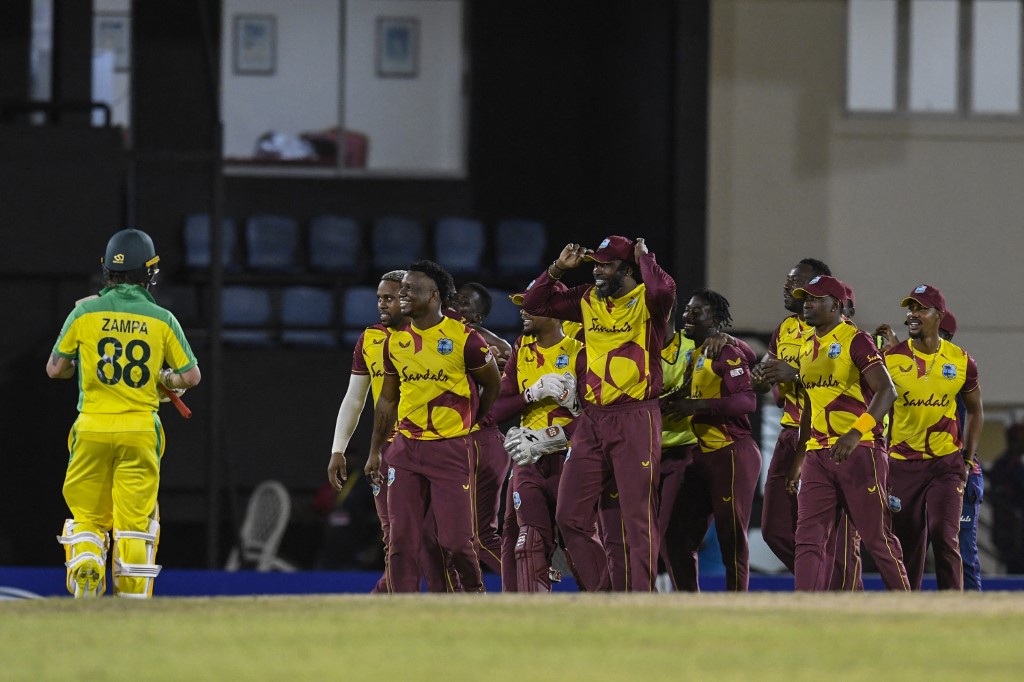A St. Lucia Tragedy: Australia and the art of how not to structure a batting line-up
Weird things have happened over the past week. Not just in Cricket, but across sports.

At Wimbledon, you had Roger Federer not just lose, but get bageled on Centre Court, an arena that not too long ago was his fortress. Wednesday was the first instance of Federer getting bageled at Wimbledon, and the second-ever of him not taking a single game in a set in a Grand Slam this entire century. At Wembley, meanwhile, you had England progress to their first major final since 1966. And they booked their place in the finale not normally, but through a favorable refereeing decision. For a country that has historically been at the wrong end of refereeing decisions in knockout matches, the script couldn’t have been more different for England against the Danes.
What happened in St. Lucia on Friday, though, was not weird by any stretch of imagination. Lended a huge helping hand by a crass middle-order collapse, West Indies wiped the floor with Australia. It was the Windies’ fourth straight victory against the Kangaroos in the shortest format, with them having not lost a 20-over match to the Aussies in over seven years. In fact, you’ll have to go all the way back to 2012 to find the last instance of Australia downing the Windies in a 20-over contest. So in many ways, despite Windies’ dubious ranking in T20 cricket (9th), the result at the Darren Sammy National Cricket Stadium did not come as a surprise.
What’s damning and scathing for Australia, however, particularly with less than 90 days left for the World T20, is that the defeat did not come as a surprise even they were coasting at 105/4 at the halfway stage, needing a mere 41 off the last 60 balls with two capable batsmen yet to come. Usually a collapse of such magnitude - 19/6 off 6 overs - is considered alarming, but for Australia, well, this has pretty much become the norm.
Cast your mind back to the decider in Auckland against New Zealand in March where they went from 103/3 in 14.1 overs to 142/8 in 20. Or the first T20I against India in Canberra last year where they went from 72-1 in 9.4 overss to 127/7 in 18.1. Or, the best of the lot, the first T20I against England in Southampton last year where they failed to chase down 163 after having been 124/1 in the 15th over, at that stage requiring 39 runs at run-a-ball. Australia have made a habit of making a meal out of their innings during the latter part, and the horror show on Friday was just another exhibit of the clownery.
Understandably, the incompetence of Australia’s middle-order has once again come to the fore. The focus was always going to be on No.4, No.5, No.6 and No.7, particularly in the absence of Glenn Maxwell, and, after the tragicomical display on Friday, the spotlight is bound to stay at the same place. But while the middle-order undeniably was egregious, it is worth analyzing the role of the team management, which exacerbated already-existing problems by constructing the batting order in the most dubious manner imaginable.
On Friday, opening with Aaron Finch and Matthew Wade (in the absence of Warner), Australia opted for a batsman-heavy middle-order that consisted of Josh Philippe, Ben McDermott, Moises Henriques, Mitchell Marsh and Dan Christian. In terms of potential, at least, it was right-up there as the best 7 Australia could have put out. The aforementioned list had accumulators, risk-takers, power-hitters and finishers, and they were also, subsequently, the top performers in the tenth edition of the Big Bash League. In short, there was no paucity of talent, experience or quality. Not to the extent of failing to chase down 146 on a flat wicket, anyway.
But talent, experience and skills are attributes that will render valuable only if they’re utilized efficiently and effectively. What the Australian management did with the individuals at their disposal, on Friday, was a 101 on how not to structure a batting line-up.
Imagine you’re the manager of the England football team. And imagine that you have Sancho, Sterling, Grealish, Kane all at your disposal, fully fit. For some reason, though, you decide to play everyone out of position: Kane starts at center back; Sterling at CM; Sancho at left-back and Grealish up-front. Should this team, after the dubious tactical decisions that were employed, suffer defeat, would it be fair to pin the blame on the players for losing 0-2? Perhaps not.
What Australia did on Friday was tantamount to the hypothetical scenario mentioned above: the individuals that were picked were comically played out of position, to the extent that their strengths got completely nullified.
Let us begin the breakdown with Mitchell Marsh, who proved to be the only success story of the night. Batting at No.3, the Western Australian struck a power-packed fifty, the first of his not-so-illustrious T20I career. Even prior to the game, coach Justin Langer announced that Marsh would be taking up the No.3 spot, and the decision was vindicated given that the powerful right-hander did everything he could to put his side in a position of command.
While the move clicked, it is worth debating if it indeed made logical sense, and if Australia had made full use of Marsh’s potential for the betterment and benefit of the side. A six-hitter by nature, Marsh had, prior to Friday, never batted in the Top 3 for Australia in T20Is. Due to his brute power, No.6 was where Marsh had slotted in maximum (9 times), with his franchise, Perth Scorchers, also deploying him in a similar role. In BBL 10, Marsh batted at No.5 in 60% of the knocks (9/15) and had great success, averaging 36.2 and striking at 158.8. He also hit 8 of his 13 sixes in that very position.
From an individual perspective, the gamble to promote Marsh paid off, but it is worth questioning if there is any long-term merit in promoting the Western Australian. Not only are Australia stacked with top-order batters, the middle-order, outside of Maxwell, has been an area of weakness for Aaron Finch’s men. The Aussies, down the order, simply don’t possess the same fireworks as India, England and West Indies, and the scarcity of lower-order hitters has continued to haunt them in the shortest format. Thus, in this case, is it prudent taking Marsh, a capable six-hitter, away from the middle-order and thrusting him at No.3 where there is no shortage of options? If indeed the management do see this as a long-term ploy, where will they fit in Marsh if and when Steve Smith eventually returns to the side?
The idea to promote Marsh to No.3 on Friday benefitted him on a personal level, but it affected the dynamic of the entire middle-order, which quite unsurprisingly wilted under pressure.
Promotion for Mitch Marsh meant a demotion for Josh Philippe, who, prior to the first T20I, had never batted at No.4 in T20 cricket. Prior to Friday, 53% of all his T20 runs had, in fact, come inside the first six overs, but despite being comfortable batting in the Top 3 - where he incidentally batted in each of the five T20Is against New Zealand - Philippe was asked to bat at 4. His failure on Friday was, of course, not fully down to the fact that he was batted out of position, but the virtue of playing a young top-order batsman out of position, in the middle-order, needs to be pondered on.
Not just the younger players, the management’s questionable decisions made life difficult for veterans, too. Despite having had all his success for the Sixers at No.4, Moises Henriques was slotted in at No.5, below Philippe. Henriques, in BBL 10, played all his innings at No.4. and enjoyed considerable success, averaging 38.8 and striking at 155.0, but in the first T20I he saw himself bat at No.5, a position where he’s batted only 15% of the times in T20 cricket (26/167). The position Henriques batted in might not have had any bearing on his dismissal, but the decision to put him at No.5 typified the flawed thought-process of the management.
The worst of the lot, and the biggest victim of the management’s goof-up, though, was Ben McDermott. A run-accumulator by nature, the Hobart Hurricanes star enjoyed an outstanding BBL 10 batting at the top of the order, scoring 402 runs at an average of 36.5 and SR of 139.6, exclusively batting in the Top 3. In a move that beggared belief, however, Australia asked the right-hander to bat at No.6, a position where he, prior to Friday, in franchise cricket, had batted only two times in. In fact, prior to the first T20I, McDermott had only ever batted three times below No.5 in franchise cricket.
The term ‘franchise cricket’ is key here as Australia have previously made life miserable for McDermott by making him bat down the order in national colours. In 4 T20Is between October and November 2018, McDermott batted at No.6 and No.7 with no success. 41 was what he managed across four innings, and those runs came at a modest SR of 95.34. You’d think the selectors, when they recalled McDermott, would have learnt their lesson, but their thought process on Friday suggested otherwise. You wonder that, deep down, the Tasmanian, after the game yesterday, would have regretted cutting his Vitality Blast stint short.
That Ashton Turner was present in the squad made the decision to bat McDermott at No.6 even more ludicrous. In BBL 10, Turner batted 8 times at No.6 (61% of his innings) for the Scorchers, for whom he played the finisher’s role. In his career, the right-hander has batted 25 times at No.6 and boasts a healthy record, striking at 146.6 whilst averaging 25.8. But despite him lurking in the squad as a specialist finisher, the management chose to deploy an opener for the role.
In hindsight, all they needed to do was swap positions and make one change. Having Philippe, Henriques and Marsh as 3, 4, 5, and deploying Turner and Christian at 6 and 7 would not just have made life easier for the players, but would also have made the batting order more balanced and stable. But by doing what they did, the management unsettled the players and, in turn, the entire batting unit.
Indeed, the management fielding these players out of position does not excuse Australia failing to chase down 146. But, ultimately, at the end of the day, a team is only as good as its plans. And notwithstanding the target that West Indies set, Justin Langer had set-up the Australian team for failure through some unwarranted tinkering that belied logic.
It'll be weird if Australia do indeed level the series on Saturday, but it’d be weirder if the management realize, acknowledge and fix their mistakes. After all, T20 cricket is not as important as the Ashes, is it?

Comments
Sign up or log in to your account to leave comments and reactions
0 Comments